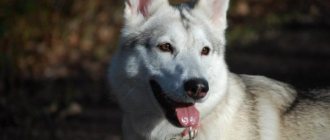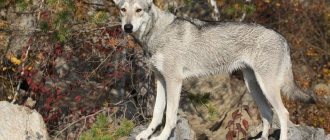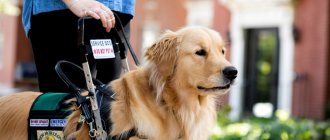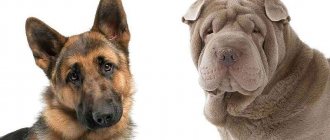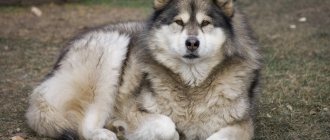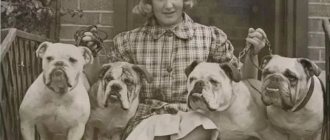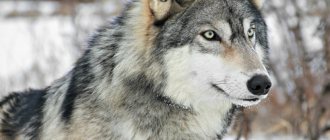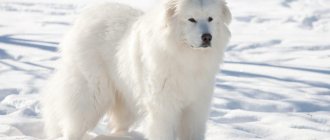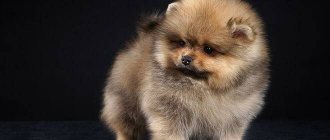A wolf dog is the dream of many animal lovers. But how adapted are such hybrids to living next to humans? The first crossbreeding of a dog and a wolf was recorded in Great Britain in 1766. A Spitz was bred with a wild animal. The resulting offspring had the appearance of a wolf, but had a softer character.
Not all dog breeds are suitable for crossbreeding. Today, several officially recognized dog-wolf hybrids have been bred; it is more correct to call them wolf-dogs or wolf-dogs. In addition, there are dogs that resemble wolves only in appearance.
Czechoslovakian wolfdog
Breeding of this breed began in 1955 in a nursery in the city of Libejovica. The ancestor of the breed was the she-wolf Brita, the father was a male German shepherd. A cross between a wolf and a dog today has 30% wolf blood.
Wolfdogs were bred with the goal of producing an animal with the endurance, strength and flair of a wolf, combined with the working qualities and controllability of a dog. The first experiments turned out to be successful - the resulting hybrid of a wolf and a dog successfully served in the border troops. In the 1970s, representatives of the breed were exported to the UK.
The wolfdog is active, intelligent, and amenable to training. Maximum attention should be paid to the upbringing and socialization of a young animal. Possible aggression towards small animals.
Wolfdog of Saarloos
This cross between a wolf and a dog was bred in Holland in 1925 by dog handler Lendert Sarloos. The ancestors of the breed were the she-wolf Flera and the male German shepherd. The best puppies were selected for further breeding. The breed was recognized and registered in 1981.
The wolf dog is quite large - up to 76 cm at the withers and up to 42 kg in weight. They are independent, live according to the law of the pack, but are attached to the owner and recognize him as the leader. Saarloos wolfdogs are wary and prefer to avoid danger. But this natural timidity does not become the cause of aggression. An interesting feature is that hybrids do not bark, but use sounds characteristic of wolves - whining, howling, growling.
A dog crossed with a wolf is used as a rescuer and guide dog. They have a developed hunting instinct, which allows them to be used as hunting dogs.
This hybrid of a wolf and a dog is quite rare, and the price for puppies is high - about $2000.
How to properly deal with half-wolves
To keep an exotic half-breed pet, you will need to create special conditions and learn how to handle them. Without certain knowledge of the physiology and psychology of mixed breeds, this venture may turn out to be a failure at best. And at worst, lead to serious irreparable consequences for both the pet and its owner.
These types are not suitable for home apartment maintenance. Throw away the idea of getting a wolf hybrid if you only have a city apartment to spare.
For content you will need:
- Lots of space away from other people and noisy highways. A farm somewhere in the forest is an ideal place to keep this breed. The following habits were passed on to the hybrids from wolves: howling loudly and constantly wandering. They need the presence of wildlife to explore. There they will not disturb their neighbors with their howling, and the noise from cars will not frighten the pets.
- The space in which wolves are kept must be at least 0.2 hectares per individual. This should be a securely fenced area with a high fence (2.5 meters) so that the animal cannot jump over it. And a deep concrete foundation so that the pet cannot dig under it.
- It is best to enclose the space for keeping hybrids with a double fence with teeth curved inward.
- It is necessary to ensure good soil drainage in the area so that animals can find dry areas in rainy weather.
- The booth is not suitable for keeping wolfdogs. It is necessary to build a spacious house with a high shelf so that the pet can occupy a position on a hill.
- Low-growing shrubs and trees should be planted on the site so that the animal finds shelter in the heat. It is unacceptable to plant tall trees near a fence - the pet may run away!
- The gates are installed high - 1.8-2 meters. Gate latches must be reliable.
Important: immediately evaluate your ability to create the right space for keeping wolf hybrids. If you are not ready to provide your pet with such conditions, give up the idea of getting a wolf-dog.
Are wolf-dog hybrids trainable?
Mixed breeds of wolves and dogs are naturally intelligent and quick-witted. But they are also stubborn, self-willed and very energetic. To keep your pet in good shape, you need 1 to 3 hours of physical activity per day. You need to walk them a lot and actively.
Let's look at the educational and training features of wolf-dog hybrid dog breeds.
- The offspring of wolves and dogs are more difficult to train. These puppies have stronger instincts and are ready to follow them.
- The person must immediately indicate to the pet that he is in the role of the alpha male. Weak owners will not be able to constantly maintain this position. The pet will always try to take a dominant position, expressing this through disobedience to the person, refusal to follow commands and demands.
- Half-breeds have a strong fear of new situations and people - this makes training difficult.
- Toilet training on the street causes certain difficulties. Wolves are accustomed to marking their territory with feces. When they defecate at home, it is a territorial instinct, not a protest.
- Wolf instincts and aggression can trigger at any moment. A pet can attack a child, another pet, livestock or bird.
Husky Wolf Mix – a hybrid of a Siberian husky and a wolf
How to feed breeds that are wolf-dog hybrids
Conventional dog food is not suitable for feeding hybrid breeds. The diet of such a dog should consist of fresh meat. The best options are wild game, elk, bison, beef, lamb, rabbit, chicken and turkey. Pork causes digestive problems and should be avoided.
The meat is given raw along with the bones. Bones are not a problem for wolf descendants. They do a great job with them. The descendants of wolves do not need cereals. Pets are given fruits, vegetables and fresh herbs as sources of vitamins and fiber. The area where the pet is kept must have grassy soil so that the animals can eat grass.
To compensate for the lack of vitamins and minerals, you need to give fortified supplements as prescribed by your veterinarian. Particular attention should be paid to access to fresh fresh water. It is best to organize a drinking trough on the site, similar to the kind they make for keeping livestock. During the hot season, it would be a good idea to place a children’s pool on the property so that your pet can drink and swim in it.
Health of wolf-dog hybrids
Crossbreeding species with different genetics has a positive effect on the health of the offspring. Puppies that result from mating between wolves and dogs are much stronger and healthier. They do not exhibit those breed genetic pathologies that are inherent in purebred dogs. This proven fact was the main reason why people wanted to crossbreed dogs with wild carnivores. But such crossing has its pros and cons.
Wolfdog
Is there a domestic wolf dog? The wolfdog breed was bred in the Perm region, at the Institute of Internal Troops. The she-wolf Naida and German shepherds were used for breeding. To successfully breed wolf-dogs, the she-wolf must not be afraid of humans. Such a predisposition must be innate. Naida was raised as a hunter from the age of two weeks and spent 3 years among people before going to college. From her, 3 generations of dog-wolf hybrids were obtained, capable of living next to a person and obeying him.
Wolf dogs serve on the border. Their sense of smell and endurance are several times greater than that of dogs. If an ordinary dog is able to pick up a scent that is 12 hours old, then a wolf dog can smell scents even after three days! And powerful jaws can bite through a protective suit.
Despite their large size and menacing appearance, wolf-dogs are easy to train and are not aggressive towards people. But raising them requires a firm hand; the owner must have unquestionable authority.
There are no Perm-bred wolfdogs available for free sale; all of them are intended for service in law enforcement agencies. Due to their external resemblance to wild wolves, they are often used for filming in feature films.
Diet
This is a predator, so the basis of the puppy’s diet should be meat. They give it raw, but previously scalded or frozen to get rid of parasites. Ready-made industrial products, the composition of which is designed with a focus on dogs, are not suitable for the digestive tract of half-wolves. Therefore, there is only one diet - natural food.
You can offer your half dog:
- beef;
- a rabbit;
- veal;
- poultry meat, cleared of bones and skin;
- offal.
The wolfdog eats a lot, so before purchasing it, you should seriously think about whether the potential owner will be able to feed this huge predator.
Important! Food for wolf-dogs should be prepared in a separate pan.
It is unacceptable to feed hybrid wolf dogs pork and lamb; this is very fatty meat, which will inevitably cause gastrointestinal diseases. They are also not fed tubular bones or food from the master's table. Clean water must be available and changed at least once a day.
The predatory nature of the wolfdog requires an appropriate feeding regime
Kunming wolf dog
A dog crossed with a wolf was also created in China in the early 1950s. Army dog handlers worked on the breed. The breed was named after the city of Kunming, the capital of Yunnan province, where it was bred. In our country it is more often called the Chinese wolf dog. The Kunming wolfdog received official recognition in 1988. This wolf-dog turned out to be quite large. Photos show that she has a menacing appearance. The height at the withers can reach 70 cm, and the weight can reach 40 kg.
The progenitors of these dogs were an unidentified couple, as in many other cases. The selection was carried out solely on working qualities and training results. In addition to 10 German shepherds with an admixture of wolf blood, 90 local dogs of unknown breed and purebred German shepherds took part in breeding the breed.
The Kunming dog serves in the army and police. She can search for mines, drugs, perform rescue work and does an excellent job as a security guard. The wolf dog becomes a pet for many. In character they are close to German Shepherds, they are easy to train, active, intelligent, curious, but they can display dominant qualities and therefore require a firm hand.
Italian lupo
The crossing of a wolf and a dog was also carried out in Italy in 1966. The breed was developed by Dr. Mario Messi. He crossed a she-wolf, one of the last representatives of the local mountain species, with a German shepherd. The Italian Lupo is perfectly adapted to life in the mountains, tolerates the local climate well and can go without food and water for a long time. In addition, the wolf dog has an excellent sense of smell and is used to detect drugs and explosives.
The Italian Lupo is intelligent, loyal to its owner and becomes his shadow. Dogs of this breed served during the Olympic Games in Turin. A special decree of the President of Italy prohibits the unsupervised breeding and sale of dogs of this breed.
Wolamuth
A dog crossed with a wolf, the Wolamute is a designer breed that became popular in 2000. The ancestors of the breed were the Alaskan Malamute and the timber wolf. A dog's appearance is variable and there is no single standard. Sizes may also vary - height from 60 to 75 cm, weight from 25 to 55 kg.
Wolamuts are active and require daily exercise. They feel good in a large area, but it must be limited by a high fence to prevent escape. It is worth warning about the possibility of undermining.
Features of Wolfops
What is the difference between a wolf and a dog and what are the features of keeping wolfdogs? Often individuals obtained from crossing a wolf with a dog retain wolf instincts. Their behavior can be destructive, and they are often aggressive towards small animals and even children. At the same time, wolf-dogs lose fear of humans and can compete with the owner for leadership. This feature makes them even more dangerous than wild wolves. Animals are very strong, and such conflicts can have serious consequences.
It should be understood that a wolf dog can be socialized, but this does not mean that it is domesticated. He is not distinguished by better health or longer life expectancy. The character of wolfdogs can vary greatly even within the same litter; the inheritance of the characteristics of a wild animal is not directly dependent on the percentage of wolf blood.
It should be understood that wolf dogs are not animals for beginners; you need to know their characteristics well, have extensive experience in keeping dogs and know wolf habits.
There are breeds of dogs that look like a wolf in appearance, but do not carry wolf blood. Such dogs are no more difficult to maintain than representatives of other breeds.
Diseases of the Russian Wolfhund
The new breed is still too young to talk about systematic observations and conclusions about the heredity of these dogs. There is no reliable data on the average life expectancy of the Russian Wolfhund, but other Wolfhunds live a long time, up to fifteen to twenty years, so there is someone to take a good example from.
“Wild” wolf blood ensured good health for the Wolfhund
It is all the more important to select only genetically proven sires for further breeding work. The Alaskan Malamute is famous for its excellent health, and the infusion of “wild” wolf blood also worked to strengthen the immunity of the hybrid offspring. But there are no perfectly healthy animals, and the new breed also has some typical problems:
- hip dysplasia - in this case, the disease is more often provoked by poor quality breeding of a large dog;
- osteoarthritis - the result of abnormal growth of knee cartilage and bones;
- inflammation of the mucous membrane of the eyes;
- short-term bouts of vomiting or indigestion.
Dysplasia is the most dangerous disease in this series; it can have very serious consequences for the animal. The first manifestations of the disease become noticeable after four months. After lying down after sleep, the puppy suddenly begins to limp on one or both hind legs; then he walks around and the lameness disappears. But this is an alarming signal, and a visit to the veterinarian should not be postponed.
The problem develops as quickly as the puppy grows and gains weight - soon he will feel discomfort and pain in the joints, his hind legs will drag, or he will even lose the ability to move independently. The disease is diagnosed in the early stages using radiographic examination. Dysplasia is treated with medication or, in the most difficult cases, through surgery.
Tamaskan dog
A striking example of such breeds is the Tamaskan dog. If the crossing of a wolf and a dog took place, it was quite a long time ago. There was no wild blood flowing into the next generations. Externally, the Tamaskan is a mixture of a dog and a wolf. The breed was developed in Finland in the 1980s. The goal of the breeders was to breed an animal that looked like a wolf, but retained all the positive qualities of a dog. For breeding, Siberian Huskies, Northern Intuits, Utonagans, Alaskan Malamutes, Finnish Husky Hounds, Czech and Sarlos Wolfdogs and German Shepherds were used. After 20 years of work, the first litter of the new breed was obtained. To date, the breed is recognized only by the American Rare Breeds Association.
Northern Inuit
In the late 1980s, breeding work was carried out in the UK. The goal is still the same - breeding an easy-going “wolf”. The origin of the breed is not reliably known. Most likely, the origins of the breed were mixed breeds of rescue dogs, Siberian Huskies, German Shepherds and Alaskan Malamutes.
Like all similar breeds, Inuit are quite stubborn and independent, so they are recommended for experienced owners.
The breed is not recognized by cynological organizations. It is the northern Inuit who can be seen in the popular series “Game of Thrones” in the role of direwolves. Sansa's wolf was played by a dog named Zunni.
Where to buy, puppy price
If you decide to purchase a puppy of this rare breed, then get ready to solve a number of difficult problems. There are no official kennels and breeders of wolf-dogs in Russia, and these dogs are not officially recognized by international canine organizations. These dogs are currently undergoing so-called field testing by the special services. It is extremely difficult to purchase a real wolf-dog; this can be done from unofficial breeders.
The price of such puppies ranges from 20,000 to 30,000 rubles, and it depends on the gender, color and origin of the puppy . However, this is associated with a certain risk, because it is unknown what percentage of wild genes such offspring have. As already mentioned, if it exceeds 20%, then serious problems with education will arise. But if you nevertheless purchased such a puppy and all its indicators are normal, then you will receive a faithful friend, guard and assistant for many years.
Utonagan
Another wolf-dog has been bred in Britain. The photos show some resemblance to the Northern Inuit, and for good reason. Initially, work on the breed was carried out in one club, but over time it was divided into 2. The formation of the breed is still taking place, and there is no single standard. For breeding, German shepherds, Siberian huskies and Alaskan malamutes were used.
Siberian Husky
What is the most popular wolf dog today? The Siberian Husky breed is currently widespread. These dogs are not aggressive towards people and cannot be used as guards. They do not quarrel with other dogs of large breeds, but in relation to small animals - cats, rabbits, small dogs - the hunting instinct can work. Huskies are active and friendly, but independent, which makes them unsuitable for service. Sled dogs can be trained to obey, but don't expect the same success as German Shepherds.
Husky is suitable for keeping in an apartment provided that it receives constant physical and mental stress. It is difficult to keep them in a fenced area, because dogs have a tendency to run away, and the hunter's instinct makes them dangerous for neighboring animals. They jump over fences and make tunnels.
Huskies have a strong pack instinct, so it is advisable to keep them in a group. These dogs do not bark, but whine and howl like wolves. The color can be very different; individuals with eyes of different colors are often found.
Maintenance and care
There is an opinion that the Czechoslovakian Wolfdog is a dog that values freedom and does not take root in city apartments. In fact, the breed is not as demanding of space as they like to attribute to it: an animal that is regularly walked, receives the necessary physical activity and enough attention from the owner, behaves calmly and unpretentiously. Breeders claim that a physically active wolfdog generally “merges” with the surrounding interior.
Woohoo
Loneliness for the Czechoslovakian Wolfdog is the number one phobia that cannot be treated, but can be slightly corrected. Of course, leaving a ward for half a day without receiving torn curtains as a “bonus”, as well as complaints from neighbors about an infernal howl, is an impossible mission. But it is quite possible to train an animal to spend an hour or two without its owner in a disciplined manner.
At first, a cage will help to avoid apartment pogroms. But keep in mind that Czechoslovakian Wolfdogs quickly “disassemble” standard designs for spare parts, and manage to open the latches, so choose the most durable shelter that is protected from dog teeth. In suburban conditions, such a restriction of movement will be an enclosure, which you can build yourself, or you can order it ready-made.
The minimum required number of daily walks for the Czechoslovakian Wolfdog is two, each lasting 1.5 hours. You can walk more - walk, less - no, if you don’t want a hurricane living at home, turning it upside down. To help your dog relax, involve him in games and sports, and come up with new activities, such as sled riding, running behind a bicycle, or lightly towing objects.
Hygiene
You will have to work minimally with the thick, dense fur of the Czechoslovakian Wolfdog. Twice a year the breed sheds profusely, but the hair does not fall out, but simply lags behind the body. At this time, the pet must be combed daily, and dead undercoat must be removed using a slicker. Wolfdogs do not need frequent bathing: their “fur coats” perfectly repel dust and do not absorb liquid dirt. As a result, all contaminants remain on the top layer of the dog and are removed from it naturally. It is best to wash your dog during the shedding period: this makes it easier to remove loose undercoat.
Puppies need to be bathed more often: little wolfdogs are not particularly neat and often get dirty in food bowls, as well as in their own excrement, turning into a walking source of unpleasant odors. The little sluts are not treated with special products so as not to remove the protective fatty lubricant: it is enough to simply wash off the dirt from the fur with a stream of warm water. Cleaning the ears with special drops and lotions is carried out only when wax accumulates. Simply “polishing” the hearing organs of the Czechoslovakian Wolfdog is not only useless, but also harmful.
The breed's eyes are healthy, so the only hygienic procedure recommended for them is preventative wiping with a clean cloth soaked in chamomile decoction. Teeth brushing is also desirable, but it is not always possible to accustom a Czechoslovakian Wolfdog to it. If the toothpaste and brush test does not work, use auxiliary means: hard treats that act as abrasives, tomato juice or ready-made plaque removers added to drinking water.
In the hayloft
Feeding
Both natural and commercial dog foods have both fans and detractors. Although experts who have been working with the breed for a long time recommend making a choice in favor of natural products. The fact is that the body of Czechoslovakian wolfdogs does not absorb starch, which is often added to “drying”. As a result, switching to commercial feed may be accompanied by diarrhea and other unpleasant symptoms. Choosing a brand that is suitable for a dog will have to be done exclusively through experience, which is not always convenient. As a rule, problems do not arise with a natural diet, unless you switch your pet to it from dry food. In this case, an adaptation period accompanied by indigestion is quite likely.
The nutritional base for the Czechoslovakian Wolfdog is meat and its waste: weathered substandard meat, cartilage, tripe. Puppies whose teeth are changing may benefit from occasionally chewing on a sugar bone. Once a week, instead of meat, it is allowed to give sea fish without bones. Cereal porridges with meat broth are not prohibited, but their share in dog food should be small, about 20%. Veterinarians also advise supplementing the natural menu with vitamin complexes, but, as the experience of breeders shows, sometimes special preparations can be replaced with more affordable products. Usually it is recommended to “vitaminize” the diet of Czechoslovakian wolfdogs with chicken yolk, brewer’s yeast, flaxseed oil, and fish oil.
Alaskan Malamute
As the name suggests, this dog breed originated in Alaska. The animals are designed to work in harness, are hardy, strong, smart and good-natured. Despite its impressive appearance, aggression towards people is not typical for the breed, but raising the dog must be done seriously and consistently. He does not fight for leadership with a person and is friendly towards new family members, including children.
The Malamute strives for leadership and quickly becomes the head of a group of dogs. But he is friendly towards small animals, including cats.
Like any working dog, the Malamute needs daily exercise. If the dog is kept outdoors, it is worth considering that Malamutes are big fans of digging holes. They rarely bark, but often make grumbling sounds.
Precautionary measures
If you type “wolf dog” in a search engine, the service will give you a lot of cute pictures confirming the friendship of a person and a beautiful, semi-wild dog. However, it is difficult to get along with him under the same roof. Animals are adopted by private individuals who have extensive experience in raising dogs and canine skills, as well as extensive territory that the pet requires for games and an outburst of energy. The wolfdog is not suitable for families with children. If you want to chat with an unusual beauty or introduce your children to the breed, it is better to visit the nursery. Under the supervision of competent specialists, you will spend unforgettable moments next to the most loving individuals, receive a lot of positive emotions and take beautiful photos. Some kennels produce dogs that love to cuddle. It is truly an incredible feeling to be hugged by a domesticated wolf weighing 70 kg.
It is worth starting a wolfdog breed of dog only if there is the possibility of strict training and compliance with all the necessary conditions of detention
Greenland dog
The Greenland dog is one of the oldest sled dogs. She is resilient, strong, and has excellent spatial orientation. These dogs were used to hunt large animals - bears, deer, seals. Despite their independence and bright temperament, Greenland dogs do not show aggression towards people and cannot be used as guard dogs. They tend to dominate other animals.
The dogs are large - from 60 cm in height and from 30 kg in weight. The fur is thick, with a dense undercoat, which protects the animal from frostbite. The color can be any except white.
When a dog and a wolf are crossed, the offspring becomes stronger, more resilient, and their sense of smell is enhanced. But due to unpredictable changes in the psyche, it is better to entrust the breeding and maintenance of wolf-dogs to professionals. And for lovers, dogs that resemble wolves only in appearance will suit them.
Kugsha
Kugsha is one of the breeds very similar to wolves, which has all the features, including character, of a wolf. This is due to the fact that the kugsha is not quite a dog, but a real wolf.
Coons were only recently domesticated in the United States, given the title of dog instead of wolf, but they have managed to become loving, eager-to-please dogs.
Unlike other breeds, the Kugsha always works with its owner. However, she still remains an intelligent and strong-willed dog who will certainly challenge her owner if she finds such an opportunity.
